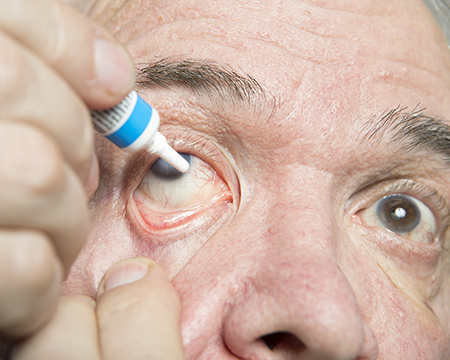
Open angle glaucoma (OAG) treatment concentrates on lowering the pressure inside the eye to prevent damage to the optic nerve. The most common treatments for glaucoma have been the use of medications in the form of eye drops or pills, and laser treatments.
With traditional argon laser trabeculoplasty (ALT), tiny evenly spaced burns are made in the trabecular meshwork with an argon laser. These burns facilitate the drainage of aqueous humor.
Selective laser trabeculoplasty (SLT) is another type of laser treatment to manage patients with open-angle glaucoma. SLT selectively stimulates or changes only specific pigmented cells to activate increase fluid drainage. Both SLT and ALT produce equivalent drops in intraocular pressure (IOP).
ALT and SLT is usually performed in the office and only takes about 15-20 minutes. Prior to the procedure, eye drops will be given to prepare the eye for treatment. The laser applications are made through a special microscope, similar to the one used for eye examinations. About 2 hours of office time should be planned so the IOP can be checked after the eye is treated.
The IOP can drop significantly in as quickly as a day or more of having the procedure. However, it can take up to several weeks to see a drop in some individuals. The doctor may treat the eye with anti-inflammatory eye drops that will be continued for 4 to 7 days after the procedure. Most patients will have to return for follow-up visits to re-check the treated eye.
Unlike some glaucoma medications, there are no incidences of allergy or systemic side effects with SLT and ALT. Complications are minimal but may include inflammation, temporary increase in IOP, conjunctivitis, or eye pain.
Eyes with so-called”narrow angles” are at risk of having angle closure occur, which is characterized by a sudden painful rise in intraocular pressure. The angle can be deepened and the condition cured by simply making a very small opening in the iris. Until the laser treatment became available, this required a surgical operation.
My current recommendation is that chronic simple glaucoma (or so-called”open angle” glaucoma) should be treated with eyedrops for as long as possible before resorting either to laser surgery or conventional surgery. With narrow angle glaucoma, however, one attack can cause irreparable damage to the interior of the eye (permanent closure of the drainage pores, irregular shape of the pupil, cataract formation, and/or damage-to the optic nerve), so an attack should be avoided at all costs.
The laser treatment is administered by me here in our surgery center with a YAG laser. Thirty minutes before the treatment, eyedrops are put in your eye which temporarily make your pupil smaller. During the laser treatment, you will be seated behind an instrument similar to one of my office examining instruments which you will have seen (slit lamp). There are no injections. Surface acting anesthetic eyedrops will be administered so that a special type of contact lens can be placed on the front of the eye. This may feel a little funny, but does not hurt in any way. The device helps me to stabilize your eye and keeps the eyelids from interfering.
The laser treatment itself consists of about one dozen separate”burns” to the iris in one spot. This will create a small hole which will later be visible to you only as a tiny dark spot. It will be very hard to see, so essentially there is no”scar”. The eye may be red for several days, even a week, but it will not be necessary to wear a patch at all. Your vision will be slightly cloudy for a least one day due to the afterimage effect of the bright lights and pigment dispersion from the treatment site.
Generally, there is some pain in the eye during the first several days, because the little muscle which opens and closes the pupil can go into spasm. You will be given Pred Forte eyedrops (or the equivalent) to instill every hour until bedtime the day of treatment and then four times daily for one week thereafter to minimize this problem. Also, you can take regular pain medication such as Tylenol (two tablets every four hours). Aspirin is a mild anticoagulant and should be avoided for one week before and after the laser treatment.
A satisfactory opening can be obtained in about 95% of people with the laser. Rarely, if ever, is regular surgery required. However, about 10% of people require two laser sessions to obtain an adequate opening. A fairly large percentage of people with narrow angle glaucoma (about 30% overall) require glaucoma eyedrops even after an iridectomy has been performed because they have some degree of chronic simple glaucoma as well. If necessary, another type of laser treatment can be administered at a later date to try to correct this portion of the problem.
If, however, your eye pressure is normal one week after treatment, all eyedrops will be discontinued and you will only need to be checked once four weeks later and at annual intervals thereafter.